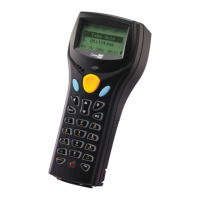27
This chapter provides detailed descriptions of the commands supported by the CipherLab
BASIC Compiler. In addition to the commands commonly used in traditional versions of
BASIC, a number of commands that deal with specific hardware features of the mobile
computers are supported. These commands are within the user’s BASIC programs to
perform a wide variety of tasks, such as communications, LCD, buzzer, scanner, file
manipulation, etc. They are categorized and described in this chapter by their functions
or the resources they work on.
Some commands are postfixed with a dollar sign, $, which means a string is returned
with the command. The compiler will accept these commands with or without the dollar
sign. However, the dollar sign will be postfixed to these commands in this manual and
the sample program.
The description for each BASIC command consists of five parts, Purpose, Syntax,
Remarks, Example and See Also, which are further described below.
Example of BASIC Command
Purpose The purpose of the command is briefly explained.
Syntax According to the following conventions, the command syntax is described.
CAPS : BASIC keywords are indicated by capital letters.
Italics : Items in Italics represent variable information to be supplied by user.
[ ] : Square brackets indicate optional parameters.
{ }
: Braces indicate an item may be repeated as many times as
necessary.
| : Vertical bar indicates alternative option.
Remarks Additional information regarding correct command usage is provided.
Example
Various ways of using
the statement are presented, including applicable and
unusual modes of operation.
See Also List of related commands is provided, if there is any.
Note: The mobile computers that support a specified BASIC command are listed to the
right of the title bar of the command.

